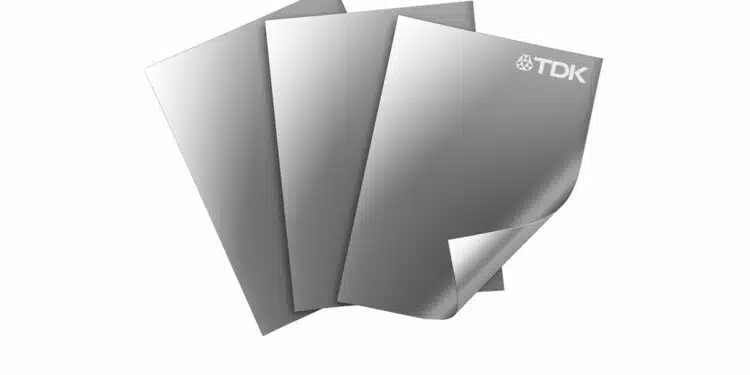TDK Corporation extended its Flexield family of permalloy thin noise suppression film sheets with the new IPM01 series, which features high-permeability and high loss in a lightweight and 0.006 mm ultra-thin design.
This new material effectively shields low-frequency band noise, which is becoming a growing issue in electric vehicles (EVs). Mass production of the product began this month, May 2024.
Over the years, electronic subsystems have been added to gas-powered automobiles for information, communications, and navigation. All of those subsystems generate high-frequency noise measured in megahertz (MHz).
EVs also integrate all of those electronic subsystems, but they eliminate internal combustion engines and replace them with electric motors and inverters that generate lower-frequency noise in the kilohertz (kHz) range. Conventional noise suppression in the kHz band requires thick shielding materials, some of which are metal. The problem is that these materials are too bulky and too heavy for EVs, where minimizing size and weight are top priorities.
This new IPM01 series is made of permalloy alloy with extremely high permeability formed into thin film sheets, meaning it can suppress low frequency band noise more effectively than conventional shielding materials and metal shields while reducing weight in automobiles. Compared to conventional TDK products, the thickness is reduced by about 80%, the weight by 90%, and the shielding effect is +65% [@1MHz].
Moreover, this new permalloy will have applications beyond the automotive market. As electronic equipment becomes smaller, thinner, and more multifunctional, noise suppression for smartphones and other devices is becoming increasingly important. By using the permalloy sheet developed by TDK, it is possible to suppress noise at 1/5 the thickness of conventional products.
The IPM01 series in the Flexield family is available as sheet material and in custom shapes. TDK will continue to contribute to the market needs by providing roll products and expanding its lineup of high-temperature types.
Features
- The ultra-thin film allows use without increasing weight or space (sheet thickness: 0.006 mm)
- 80% reduced thickness, 90% reduced weight, and +65% [@1MHz] shielding effect, compared to conventional TDK products
- High noise absorption due to high permeability (permeability below 1MHz: Typ. 1000)
- Good shielding characteristics over a wide bandpass from low to high band frequencies
- Since the permalloy alloy surface is a conductor, the noise suppression effect can be further enhanced through grounding
- Options include conductive or non-conductive double-sided tape
- Sheet materials and custom cuts to meet customer needs are available
Applications
- Automotive subsystems (operating temperature environment from -40 °C to +85 °C)
- Smartphones and wearable devices































